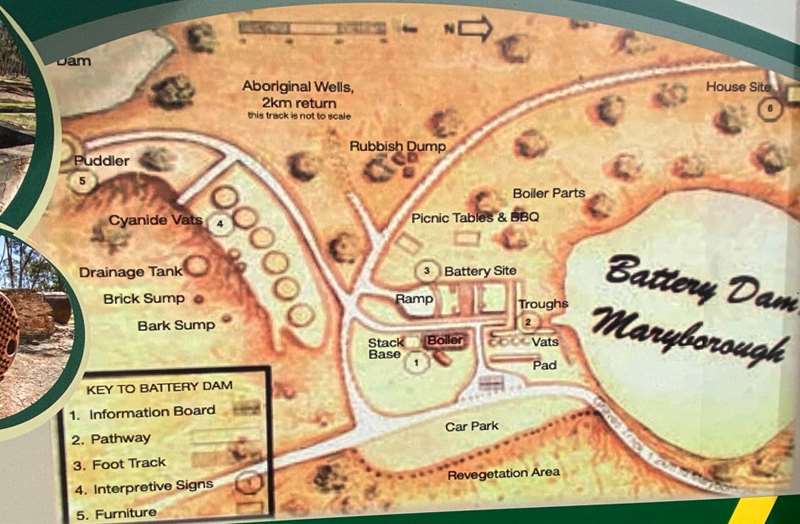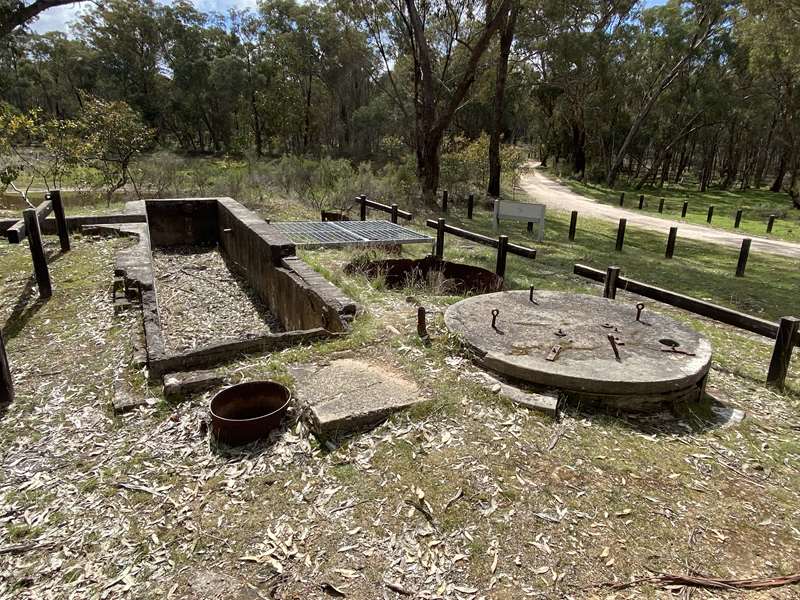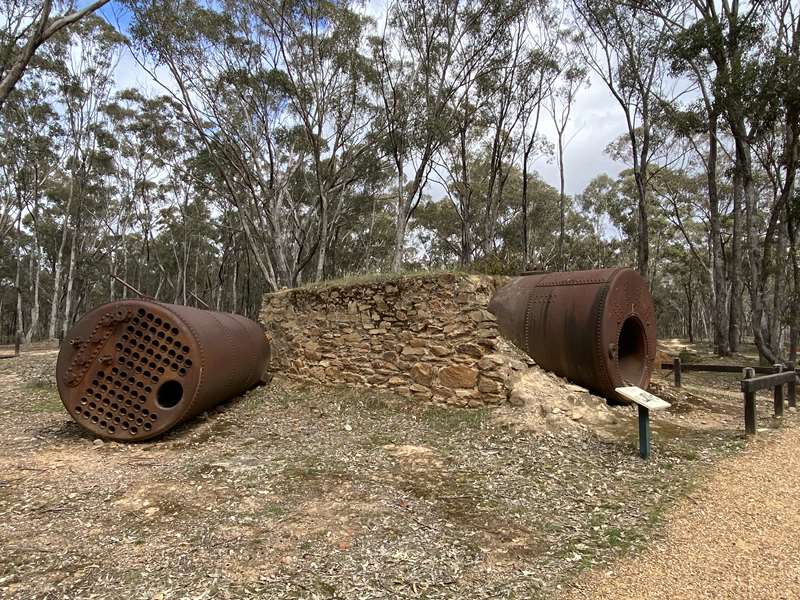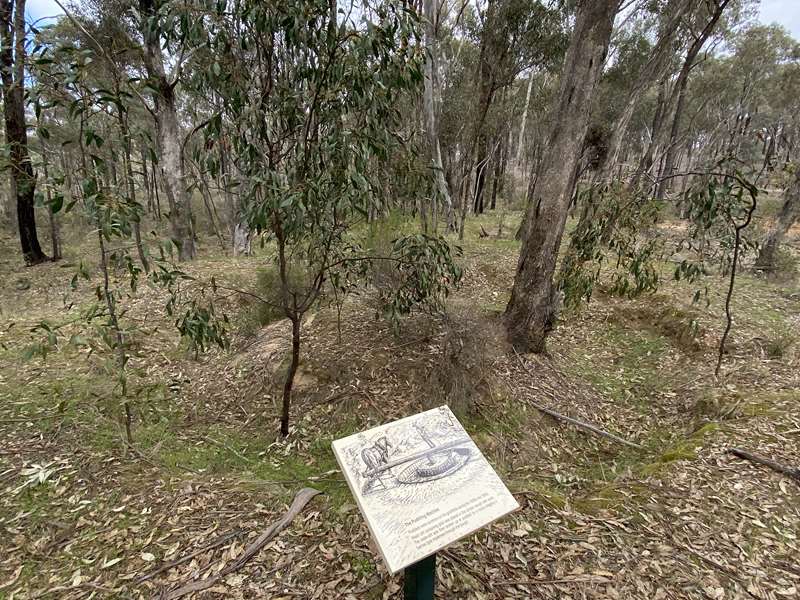Daisy Hill - Bull Gully Battery Dam and Distillery


The area's first inhabitants were the Jajowurrong people. Evidence of how these people survived can be found at Bull Gully Rock Wells. These unique-wells provided a valuable source of drinking water by collecting rain in trenches dug from outcropping sandstone. The lives of the Jajowurrong were changed forever by the discovery of gold.
In 1854 a 15.25kg (537ounce) nugget was found about 1 km north of Battery Dam. In 1855 an even larger, 833.14 ounce nugget was found at Blackman's Lead. The rush was on, thousands of hopefuls flocked to the district. The quest for gold has left its mark in the forest around Battery Dam.
Hundreds of "diggers" holes dating back to the 1850's can be still observed in gullies throughout the forest. Deep lead mining commenced in the late 1850's with numerous shafts sunk to mine rich, gold bearing quartz veins. Chemical extraction of gold using cyanide commenced in the 1870's and again in the 1930's. Evidence of all these activities can be found at Battery Dam today.
In 1917, eucalyptus distilling commenced here and continued until the 1950's. A walking track to Bull Gully (Aboriginal) Rock Wells is an excellent way to experience the Box Ironbark forest. This is an easy 2km return walk and will take approximately 45 minutes to complete.
Bull Gully Battery Dam and Distillery Map


Information Signs at Site
There are a number of information signs at the site (some in better shape than others). The text is:
STAMP BATTERY
This is the site of a "ten head" stamp battery used to crush quartz from mines in the area.
Horse drawn drays brought the quartz to the battery. the drays were backed up the earth ramp and their loads tipped into the bottom of the battery boxes. Heavy stamps were lifted and dropped, pulverising the quartz into sand sized particles; enabling the gold to be retrieved.
The boiler produced steam for the battery engine. When the battery was closed, the boiler was adapted for the eucalyptus distillery.
CORNISH BOILER

Set in a stone wall like structure the boiler supplied the steam to operate the stamp battery which crushed the quartz rock. The second boiler was brought to the site at a much later date.
CYANIDE VATS

Set on part of the tailings dump (the grey white residue from the crushed quartz), are the remains of six cyanide vats. Sand from the tailings dump was re-treated in a cyanide solution to recover the gold left after the crushing process. Cyaniding enabled so much extra gold to be recovered that it became economic to re-process old tailings. Virtually all the old tailings were re-treated at the turn of the century, and many were done again in the 1930's.
THE PUDDLING MACHINE

Puddlers were common on the goldfields during the 1850's and 1860's. Wash dirt containing gold was placed in the circular trough with water. The wash dirt was then broken up or puddled by a horse dragging a harrow type implement through the trough.
STEP BACK IN TIME
The local Jaara Jaara indigeonous people have occupied the Box-Ironbark forest area for thousands of years. The dialect for the local area is known as Djadjawurrung. The Jaara Jaara people have a special connection with the land they belong to. The forest provided the people with all the food and shelter needed to survive and in return they respected and looked after the land. As you can imagine, in this dry harsh country, water at times is often scarce. The Jaara Jaara people were able to overcome this problem by making rock wells that provided a reliable source of water during dry periods. An excellent example is the Bull Gully Rock wells only a 1 km easy walk from here. Take this opportunity to admire this significant site and imagine a life living on the land as the Jaara Jaara people once lived.
The arrival of European settlers contributed to the demise of the Jaara Jaara people as they were overcome by introduced diseases and traditional ways were restricted by European settlement. Their people and their way of living were drastically changed forever. Today the remaining Jaara Jaara people still share a special connection with the land and the Box-Ironbark forest. The Jaara Jaara people are strongly involved in forest management and continue to strengthen their culture.
Maryborough and the surrounded areas were infected with gold fever when the gold rush began June in 1854. The efficiency of the bush telegraph meant that Maryborough grew from a mere 100 miners in June 1854 to a chaotic bustling swarm of 25,000 miners in September 1854. The miners had it tough; living and working conditions were harsh and unsanitary. The quest for gold has left its mark on this area with hundreds of diggers' holes in the gullies and surrounding bush. Much of the Box-Ironbark forest was cleared to produce timber for mine shafts and boiler fuel. Later, on the most fertile soils, the forests were cleared for farmland and the timber was used for construction.
On your walk, look for the 'puddler', an early method for gold extraction along with the remains of a quartz battery and cyanide vats. You can also see the remnants of one of several eucalypt oil distilleries that started up in the forest early this century, producing Australia's first unique pharmaceutical product.
EXPLORE OUR BEAUTIFUL BOX-IRONBARK FOREST
Our Box-Ironbark forests tell a fascinating story of change and survival. How you use the forest today will shape our forests of the future. How will you shape the next chapter?
The Box-Ironbark ecosystem represents a precious and unique environment that provides habitat to numerous native plants and animals. Predominant overstorey species include Grey Box (Eucalyptus microcarpa), Red Box (E. polyanthemos), Yellow Gum (E. luecoxylon) and Red Ironbark (E. tricarpa). The large grey box located near the picnic tables is thought to be over 250 years old, this old veteran would have lived with the Jaara Jaara people before settlers arrived and later would also have witnessed the chaos of the gold rush era.
The understorey is made up of many different species including Golden Wattle, Hedge Wattle and Drooping Cassinia or Chinese Scrub. Wildflowers are abundant during the spring and early summer and include Black Anther Flax Lily and delicate Everlastings. Please help to protect the Box-Ironbark flora by leaving plants as you found them.
On your walk you will be greeted by the calls of beautiful Box-Ironbark birds. Listen and look carefully and you may find signs of Yellow Tufted Honeyeaters, White-throated Tree Creeper and Currawongs. If you are lucky you may come across some of the locals that call Box-Ironbark forest home including; Short-beak Echidnas, Black Wallabies and nocturnal Ringtail Possums. The Box-Ironbark forest is particularly important because it is the preferred habitat of several of Victoria's threatened species, including the Brush-Tailed Phascogale or Tuan, the Sugar Glider, Powerful Owl, and the Swift Parrot.
Today, Craigie State Forest is managed for multiple uses including tourism, recreation, honey production, firewood, timber and natural values. Sustainable harvesting and production of timber from the Craigie State Forest is monitored under the code of Forest Practices for Timber Production and through local harvesting prescriptions. The monitoring is designed to ensure the environmental, cultural and historical values of the forest are protected for this and future generations.
THINGS TO DO
Battery dam is a great place for a lazy picnic and a stroll through some historical sites left behind by the gold rush era. There are numerous other activities that can be enjoyed. Please help keep our Box-Ironbark beautiful by reducing your impacts and taking your rubbish home.
Prospecting
Prospecting can be an exciting experience that involves searching for gold, gemstones or other minerals. Many of the world's largest nuggets have been found in areas not far for Maryborough. All prospectors require a Miner's Right which is a permit for prospecting in Victoria and must be carried at all times while prospecting. Prospecting is permitted in most State Forests and many reserves. Please respect historical sites that you may find and fill in any holes you make.
Bushwalking
Bushwalking is one of the best ways to explore and experience Box-Ironbark forest. However, take care for mine shafts when walking through the forest. In State forest you can bring your dog along too, but please keep your dog under direct control at all times and for comfort of others, please keep them on a leash when in picnic and camping areas. If you are lucky and observant, on your walk you may stumble across some hidden relics of the gold mining era. In spring and early summer wild flowers blanket the forest floor and fill the forest with colour. Why not take a short walk through the beautiful Box-Ironbark Forest to Bull Gully Rock Wells?
Camping
Camping is permitted within the State Forests and is a great way to relax and enjoy the Box-Ironbark surroundings. Most of the camping spots are informal bush camps suitable for the self-sufficient camper who enjoys 'roughing it'. Be sure to leave your bush camp the way you found it and take your rubbish home.
Campfires
Sitting around a camp fire is a great way to enjoy the evenings camping out in the Box-Ironbark Forest. Take care with fire and observe all fire regulations and total fire ban days. Collect only dead wood from the ground for campfires and always use existing fireplaces where possible, if a fire place does not already exist then build your fire in a pit 30 cm deep. Fires must be less than 1 metre square and at least 3 metres clear of flammable material. Never leave fires unattended and ensure fires are safe and that they are completely extinguished when you leave.
Birdwatching
Grab your binoculars because the Box-Ironbark forest is home to numerous bird species and is an ideal location for bird enthusiasts. This area provides habitat for some endangered bird species including the Swift Parrot and the locally endangered Bush Stone-curlew.
Forest drive
Box-Ironbark forest contains a maze of interesting tracks suitable for a forest drive. Take care because minor forest roads can become boggy in winter, so stay on major roads in wet weather. Vehicles and trail bikes must be registered and roadworthy and may only be driven on designated public roads and tracks.
How to get there
Battery Dam is located approximately 3km south of Maryborough off the Maryborough/Majorca Road (Inkerman Street). Enter Graves Track and travel west about 1.2km along the track to Battery Dam. Look out for a sign beside Majorca Road which says "Battery Dam Historical Site 1.2km". The track is negotiable by 2WD cars.
Review:
A really interesting area to explore with extensive remains from the gold mining and eucalyptus distilling periods and the starting point for a walk to the Bull Gully Aboriginal rock wells.
There is a carpark beside the road and the historic site is very close by. Facilities include two unshaded tables and wood BBQs.
Photos:
Location
Graves Track, Daisy Hill 3465 View Map








